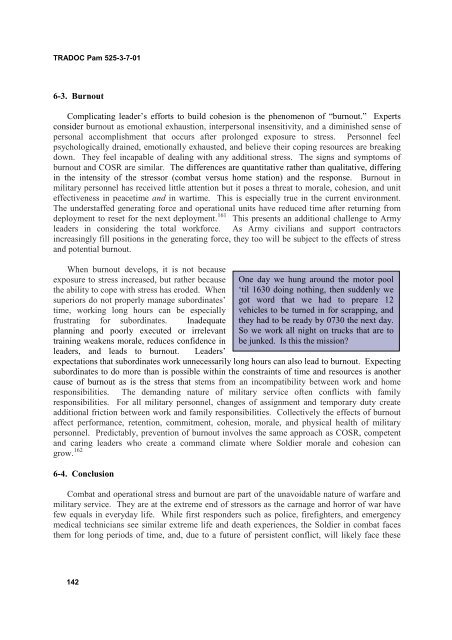TRADOC Pam 525-3-7-01 - TRADOC - U.S. Army
TRADOC Pam 525-3-7-01 - TRADOC - U.S. Army
TRADOC Pam 525-3-7-01 - TRADOC - U.S. Army
- No tags were found...
Create successful ePaper yourself
Turn your PDF publications into a flip-book with our unique Google optimized e-Paper software.
<strong>TRADOC</strong> <strong>Pam</strong> <strong>525</strong>-3-7-<strong>01</strong>6-3. BurnoutComplicating leader’s efforts to build cohesion is the phenomenon of “burnout.” Expertsconsider burnout as emotional exhaustion, interpersonal insensitivity, and a diminished sense ofpersonal accomplishment that occurs after prolonged exposure to stress. Personnel feelpsychologically drained, emotionally exhausted, and believe their coping resources are breakingdown. They feel incapable of dealing with any additional stress. The signs and symptoms ofburnout and COSR are similar. The differences are quantitative rather than qualitative, differingin the intensity of the stressor (combat versus home station) and the response. Burnout inmilitary personnel has received little attention but it poses a threat to morale, cohesion, and uniteffectiveness in peacetime and in wartime. This is especially true in the current environment.The understaffed generating force and operational units have reduced time after returning fromdeployment to reset for the next deployment. 161 This presents an additional challenge to <strong>Army</strong>leaders in considering the total workforce. As <strong>Army</strong> civilians and support contractorsincreasingly fill positions in the generating force, they too will be subject to the effects of stressand potential burnout.When burnout develops, it is not becauseexposure to stress increased, but rather becausethe ability to cope with stress has eroded. Whensuperiors do not properly manage subordinates’time, working long hours can be especiallyfrustrating for subordinates. Inadequateplanning and poorly executed or irrelevanttraining weakens morale, reduces confidence inleaders, and leads to burnout. Leaders’One day we hung around the motor pool‘til 1630 doing nothing, then suddenly wegot word that we had to prepare 12vehicles to be turned in for scrapping, andthey had to be ready by 0730 the next day.So we work all night on trucks that are tobe junked. Is this the mission?expectations that subordinates work unnecessarily long hours can also lead to burnout. Expectingsubordinates to do more than is possible within the constraints of time and resources is anothercause of burnout as is the stress that stems from an incompatibility between work and homeresponsibilities. The demanding nature of military service often conflicts with familyresponsibilities. For all military personnel, changes of assignment and temporary duty createadditional friction between work and family responsibilities. Collectively the effects of burnoutaffect performance, retention, commitment, cohesion, morale, and physical health of militarypersonnel. Predictably, prevention of burnout involves the same approach as COSR, competentand caring leaders who create a command climate where Soldier morale and cohesion cangrow. 1626-4. ConclusionCombat and operational stress and burnout are part of the unavoidable nature of warfare andmilitary service. They are at the extreme end of stressors as the carnage and horror of war havefew equals in everyday life. While first responders such as police, firefighters, and emergencymedical technicians see similar extreme life and death experiences, the Soldier in combat facesthem for long periods of time, and, due to a future of persistent conflict, will likely face these142



